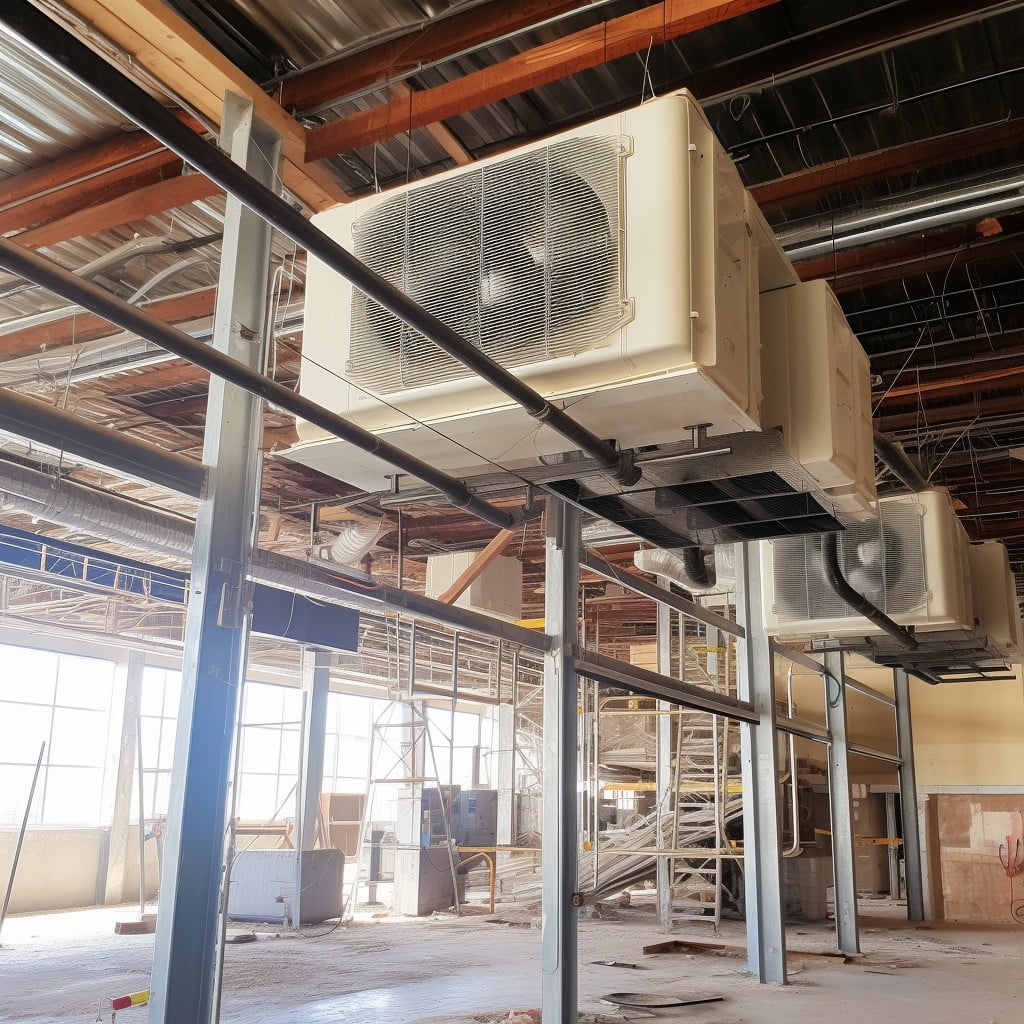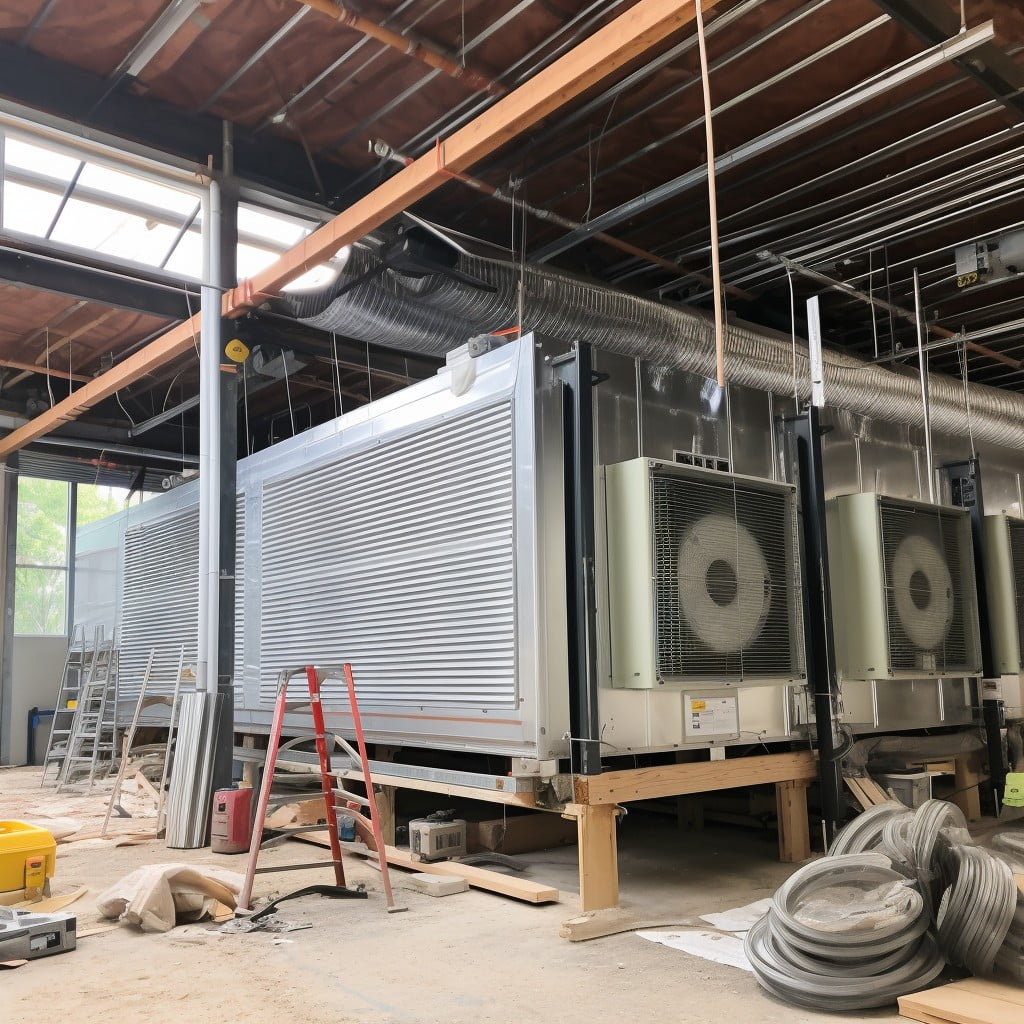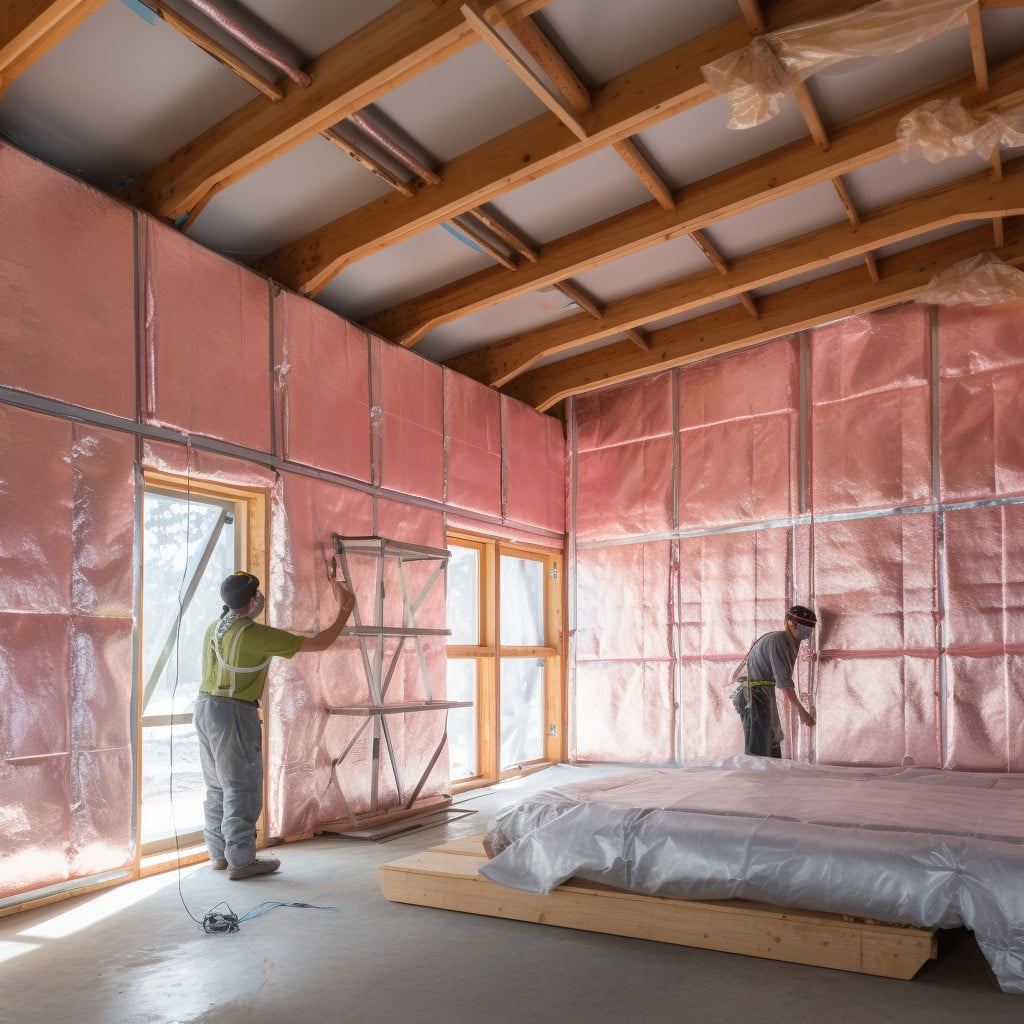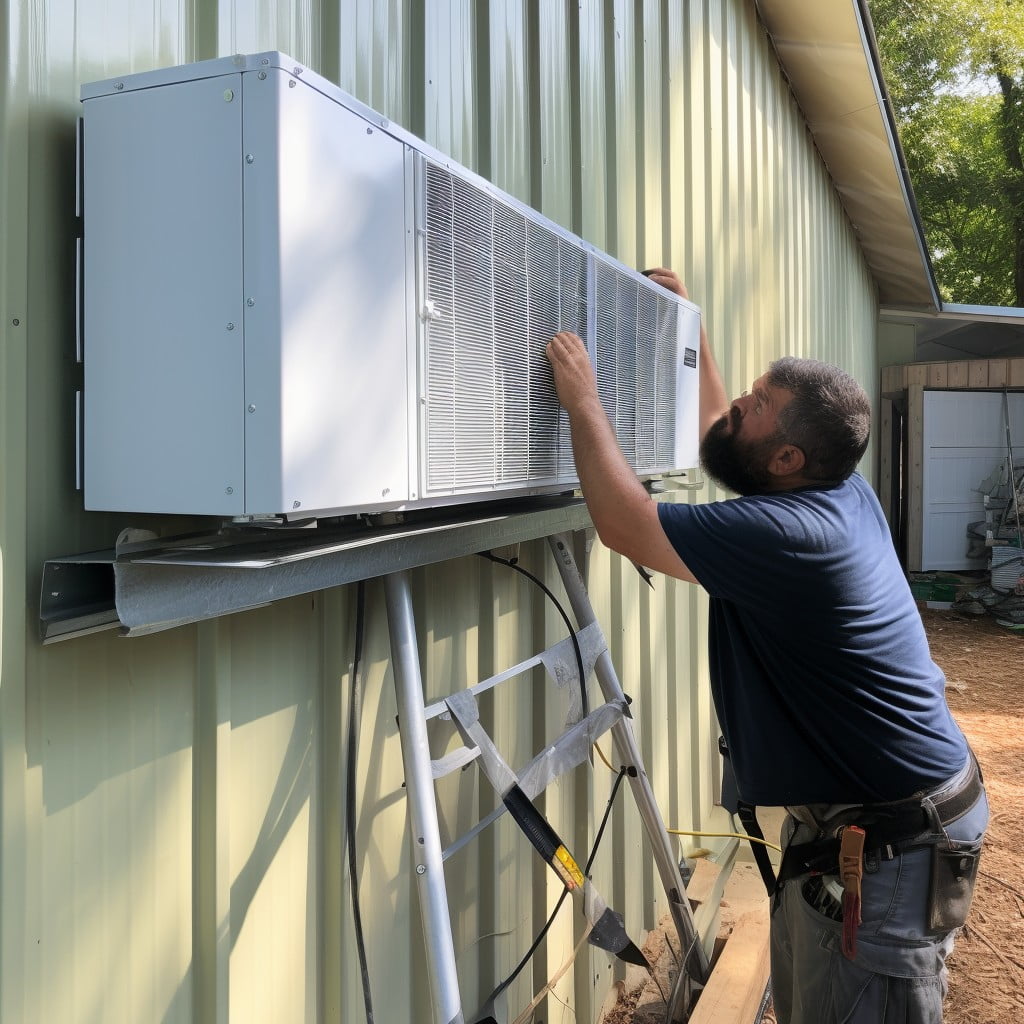Discover the straightforward process of installing an air conditioner in a metal building, ensuring optimal comfort and efficiency.
Installing an air conditioner in a metal building can be a straightforward process when done correctly. This article will guide you through the necessary steps, from selecting the appropriate AC unit to the actual installation. You’ll learn about the importance of proper insulation, the correct positioning of the unit, and how to secure it safely in a metal structure. Whether you’re working with a window unit or a central air system, this comprehensive guide will provide the detailed information you need to successfully cool your metal building.
Key takeaways:
- Choose the right air conditioner based on size, energy efficiency, type, and noise level.
- Plan for your metal building’s HVAC system by considering building size, insulation type, regional climate, and regular usage.
- Install good insulation in your metal building to increase efficiency and prevent condensation.
- Follow specific steps to install a window A/C unit in a metal building, including attaching brackets and using sealing foam.
- Maintain your air conditioner by regular cleaning, inspection, ventilation, professional service, and thermostat setting.
Choosing the Right Air Conditioner for a Metal Building

To ensure the optimal comfort within your metal building, choosing an appropriate air conditioner is vital. The first consideration should be size, measured in British Thermal Units (BTUs). The larger your metal structure, the more BTUs your air conditioner will require to adequately cool the space. It’s advisable to consult an HVAC professional for precise BTU calculations.
Energy efficiency is another key factor. Look for units with a high Energy Efficiency Ratio (EER), which signifies more cooling power per watt of energy. This not only ensures better performance, but can also save you money on electricity bills in the long run.
Third, consider the air conditioner type. Central air, window units, or portable air conditioners each have distinct features and benefits. Central air can cool large spaces evenly, while window and portable units can be more cost-effective and easier to install. However, central air requires a more complex installation process involving ductwork.
Lastly, take into account the noise level of the unit. While all air conditioners make some noise, models that are specially designed to be quiet can greatly enhance the comfort and usability of your metal building.
Planning for Your Metal Building’s HVAC System

When planning your HVAC system, keep in mind factors such as building size, insulation type, and regional climate. These will greatly affect the power performance needed for effective temperature control in a metal structure.
1. Building Size: The structure’s physical size, including height, will directly influence the requirements of your air conditioning unit. The larger it is, the more powerful your HVAC system needs to be to maintain a comfortable temperature.
2. Insulation Type: Proper insulation decreases heat gain, reducing the workload on your air conditioner. Therefore, choosing appropriate insulation for a metal structure is crucial.
3. Regional Climate: Consider temperature and humidity levels typical for your area. More hot and humid regions, like the Southeast, will demand a more powerful AC unit, compared to cooler areas, such as the Midwest.
4. Regular Usage: Factor in the purpose of your metal building and the number of occupants. If it’s a workshop with heavy machinery or a consistently occupied office, additional cooling power will be needed to counteract heat output.
Remember, a well-planned HVAC system translates to better temperature regulation, leading to lower energy costs over time.
How to Install Good Insulation in Your Metal Building

To ensure your air conditioning operates at peak efficiency, insulation is key. Select the right insulation material prioritizing both thermal resistance (R-value) and permeance (the rate at which water vapor can pass through a material).
Start by cleaning the interior side of the walls. Remove any dust or dirt that might affect the adhesion of insulation. Measure the area for insulation carefully. Cut the insulation panels according to the measurements. Afterward, the insulation panels should be fitted securely between the frame of the walls. Ensure there are no gaps or cracks between the panels.
For metal roofing insulation, a radiant barrier can be highly effective. Lay the radiant barrier over the roof purlins before the metal panels are installed. This helps reflect the sun’s heat away from the building, increasing the efficiency of your air conditioner.
Remember, every edge, corner, joint, and surface in your metal building plays a decisive role in maximizing insulation. Pay close attention to doors, windows and include weatherstripping for a tighter seal reducing air leakage. Finally, consider the importance of proper ventilation alongside insulation to prevent condensation and maintain indoor air quality.
Window A/C Unit Installation in Metal Building

When mounting an A/C unit into a metal building’s window, initially the most important factor to consider is the size of the unit. It needs to fit within the window’s dimensions, ensuring an exact match or slightly smaller size for an effective seal.
Equally vital is the unit’s capacity in relation to the space it will cool. Oversized units can lead to excessive electricity bills, while undersized ones may struggle to adequately cool the area. Always examine the BTU rating, an indicator of the unit’s cooling capacity for a specified square footage.
Once the unit is correctly selected according to size and capacity, the next steps for installation are as follows:
- Attach the brackets that come with the window unit A/C. Ensure a secure fit to hold up the weight of the appliance.
- Carefully place the unit into the window, resting it onto the brackets. The unit should tilt slightly backwards to enable condensation runoff.
- Lower the window sash to secure the unit from the top.
- At all junctions between the unit and window, use window sealing foam to block potential air leaks.
With these steps, installing a window A/C unit in a metal building becomes a straightforward process. Remember to follow the manufacturers’ manual for specific instructions catered to your model.
Why You Should Add High-quality Insulation to Your Metal Building
High-quality insulation plays a critical role in managing the energy efficiency and comfort of your metal structure. Firstly, it reduces heat transfer, keeping the building warmer in winter and cooler in summer.
Secondly, it aids in preventing condensation, which can lead to damaging rust over time.
Also worth noting, it boosts noise control, minimizing external noises for a quiet indoor environment.
Lastly, proper insulation can lead to significant savings on energy bills. It keeps the air conditioner from overworking to maintain desired temperatures, thus prolonging its lifespan and reducing repair costs.
Remember, the effectiveness of insulation is measured by its ‘R’ value. The higher the ‘R’ value, the better the heat resistance and insulating effectiveness. Choose insulating materials with higher ‘R’ values for best performance.
Steps to Install the Air Conditioner in Metal Building
Begin by determining the ideal position for your unit. It should be a location that allows for optimal air flow and is easily accessible for maintenance. Next, cut a hole with the same dimensions as your air conditioner according to the manufacturer’s instructions.
Ensure you have sturdy brackets in place to support the weight of your unit. Using a level, confirm that the brackets are even. Once that’s confirmed, secure the brackets using screws designed for metal surfaces.
Now, place your unit on the brackets. It should fit snugly in the hole and rest evenly on the brackets. Secure it in place with screws, ensuring it’s firmly fixed yet not overly tightened to prevent causing damage.
Next, connect your air conditioner to the power supply. Make sure the power source matches the voltage required by the unit to avoid electrical problems.
Finally, seal the edges of the unit with weather-stripping or foam insulation to prevent air leaks and enhance efficiency. This also protects your metal building from possible corrosion caused by moisture.
Remember to follow the manufacturer’s instructions throughout the installation process for the best results. Regular cleaning and maintenance will help increase the longevity and efficiency of your unit.
Maintenance Tips for Air Conditioner in Metal Building
Maintaining your air conditioning system is key to preserve its efficiency and prolong its lifespan. Regular checks and swift repairs can prevent serious breakdowns that could impact the climate within your metal building.
Below are a few tips to assist with maintenance:
- Regular Cleaning: Over time, dust and other particles can accumulate within the A/C unit, reducing its efficiency. Clean filters and coils every month during peak usage periods to maintain optimum performance.
- Inspection: Check for any leaks or damage to the unit. If you notice water pooling around the air conditioner, contact a professional technician to assess the situation.
- Ventilation: Ensure vents are kept clear of any hindrances like furniture or boxes. This maintains airflow efficiency, reducing the amount of stress on the unit.
- Professional ‘Check-Up’: Make sure to have a professional service your A/C unit annually for optimal performance. This covers things you may miss, like refrigerant levels or mechanical wear and tear.
- Thermostat Setting: Consistent adjustment of the thermostat could lead to overuse of the A/C unit. Keep a steady temperature setting as this extends the life of the system.
Adhering to these measures will effectively maintain your air conditioner, keeping your metal building comfortable during those warmer months.
FAQ
How do you cool the inside of a metal building?
To cool the inside of a metal building, consider implementing reflective window pane glass and light-colored doors to deflect heat, as well as investing in window fans and air conditioning units.
How to install an air conditioner in a storage shed?
Installing an air conditioner in a storage shed entails selecting and fitting a ductless AC unit, either a mini-split, window, or portable version, due to their non-complex installation process.
Do wall mounted AC units need to be vented?
While the majority of wall-mounted AC units require ventilation, there are specific models available that function without the need for venting.
What is the optimum positioning for an air conditioner in a metal structure?
The optimum positioning for an air conditioner in a metal structure is in a central location where the cool air can easily circulate throughout the building.
What specific requirements need to be considered for ductwork installation in a metal building?
Ductwork installation in a metal building requires consideration of specific requirements such as the size and layout of the building, local building codes, placement for efficient airflow, insulation to prevent condensation, and proper sealing to ensure air quality and energy efficiency.
Can you retrofit a metal building with central air conditioning without compromising its structural integrity?
Yes, you can retrofit a metal building with central air conditioning without compromising its structural integrity, provided you follow proper installation guidelines and regulations.
Recap




